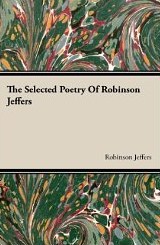I have on my bookshelf Can Poetry Save the Earth: A Field Guide to Nature Poems (2010) by John Felstiner. I found it in the gift shop at the Missouri Botanical Garden, in the “ecology and activism” section. It’s the kind of book I can’t read straight through. Too much of a fixation on a theme (especially a political theme) is a bit too much to take at once; it’s better consumed in small bites.

This collection is not for the fainthearted. The first poem is “Tamar, ” a narrative poem that occupies about 60 pages of the 600-page work. This is the poem, in fact, that established Jeffers as a major poet when it was first published in 1924. If you’re familiar with the novels of William Faulkner, especially The Sound and the Fury, you will be familiar with some of the themes and ideas of “Tamar, ” themes like violence, incest, and illicit love. To be fair to Jeffers, “Tamar” came before The Sound and the Fury; if there was influence involved, then Faulkner was the one influenced.
Selected Poems contains several long poems, although none as long as “Tamar.” Long narrative poems require close reading; otherwise, you can lose the thread of the story. Most of the poems in the collection, however, are about nature, geography, topography, and the natural world. Here’s one example:
People And A Heron
A desert of weed and water-darkened stone under my western windows
The ebb lasted all afternoon,
And many pieces of humanity, men, women, and children, gathering shellfish,
Swarmed with voices of gulls the sea-breach.
At twilight they went off together, the verge was left vacant, an evening heron
Bent broad wings over the black ebb,
And left me wondering why a lone bird was dearer to me than many people.
Well: rare is dear: but also I suppose
Well reconciled with the world but not with our own natures we grudge to see them
Reflected on the world for a mirror.
As a child, Jeffers was trained in the Bible and theology; his father was a Presbyterian minister. Before he became a full-time poet, he tried his hand at a number of things. A volume of verse was published in 1916, but it was “Tamar” that established his reputation. He and his wife Una lived at Tor House in Carmel, California, and much of his poetry reflected the region.

Jeffers’ poetry is rugged, reflective of the terrain that figures so largely in his work. It might even be best read in a nature preserve, a national park, or someplace away from the noise of civilization, or perhaps overlooking the Pacific Ocean near Carmel.
Featured photo by Victor Camilo, Creative Commons, via Flickr. Post by Glynn Young, author of the novels Dancing Priest and A Light Shining, and Poetry at Work.
Want to brighten your morning coffee?
Subscribe to Every Day Poems and find some beauty in your inbox.
- Poets and Poems: Beth Copeland and “I Ask the Mountain to Heal My Heart” - July 10, 2025
- A.E. Stallings: the Parthenon Marbles, Poets, and Artists - July 8, 2025
- Poets and Fables: Steven Flint and “The Sun and the Boy” - July 3, 2025

Maureen Doallas says
Jeffers built the Tor House outbuilding “Hawk Tower” in Carmel. I had a bit about that in one of my Monday Muse posts last year. Fascinating place that I would like to visit someday. There’s a festival there in October, which this year is “Jeffers and the Wilderness”. The group that runs Tor House also conducts an annual spring poetry series.
Fine post, Glynn.